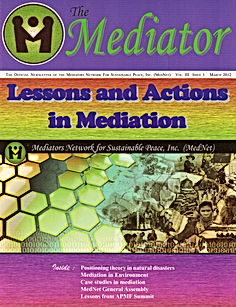Lessons and Actions
in Mediation

Kapayapaan! Welcome to another issue of The Mediator!
The art and science of mediation is as dynamic as can be. Mediators are wont to continue on learning by sharpening the mediation and conflict discourse and honing their skills through practice. Lessons (discourse) and actions (practice) are what make the latest issue or our newsmagazine.
A mediation guru in her own right, Brenda Batistiana writes about discursive psychology, positioning theory and Foucaldian discourse analysis as analytical lenses in understanding the narratives of people about natural disasters, such as the super typhoon Ondoy which hit most of Metro Manila and neighboring areas more than two years ago. Through this, we gain insights on how positional analysis – through the dynamic positioning triangle of storyline, position and meaning – can be a powerful tool in finding solutions to conflicts. This discourse is given more fresh in the book “Land Tenure Stories in Central Mindanao” reviewed here by MedNet’s friend Ronet Santos. Meanwhile, Carol Peteros reflects on MedNet’s intervention in environmental disputes especially in mining cases.
Six case studies depict community mediation in action. One of them was a failed attempt, one rendered moot by an act of the parties, one abandoned by the parties, and two remain in progress albelt already with some measure of success. But more than their success or lack of it, these cases are powerful triggers of learning and discourse. The case of the returning evacuees tells us of the appropriateness of the venue for mediation. That of boundary dispute highlights the importance of technical data in resolving data conflicts. The aerial spraying case raises the question of whether timing (of intervention) affects the “mediatability” of a conflict. The rido case emphasizes the precedence of customs and traditions in resolving violent clan conflicts. The overlapping land claims tells how a MARO, acting as a mediator, helped disputing claimants find a mutually-acceptable solution. Lastly, the post-land acquisition case tells of the importance of a united group of disputants in facing up to a powerful adverse party, and the role of a mediator who espouses EDRMP in effecting such unity without sacrificing his or her neutrality. We thank our members Edwin Golosino, Luz-Canave-ANung, Paul Paulin and Floro Astillo for documenting these cases. Incidentally, please note that the names of people and places in most of these cases are not revealed to protect the privacy of the parties.
This publication is also a tool for strengthening MedNet as a network. Thus, we added some snapshots of our General Assembly as the UP Los Baños last January 16, along with the organizational report which I delivered in that same occasion. In addition, Che Aquino and myself share the most important insights we picked up from the recent APMF summit we attached in Bangkok.
We end this issue with a happy note-that of the new grant extended to MedNet by Miserior. We hope that this three-year project, the basic information on which is outlined here, will engender active participation of our members and partners.
Mabuhay and MedNet!
